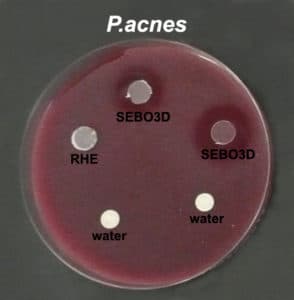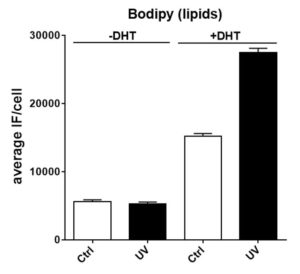Acne vulgaris: physiopathology and cell mechanisms
Clinical signs
Acne is a widespread skin condition. It is estimated that 4 out of 5 adolescents will be affected by a more or less severe form of acne during puberty.
According to the severity of the disease, different clinical signs may occur. Acne is generally characterized by the formation of microcomedones, blackheads, papules, pustules and nodules according to severity. If acne mostly affects adolescents, it can also affect adults (pregnant women, middle-aged men) and infants. Clinical signs are often limited to the face but may also be found on the neck, upper back, chest, lower arms and shoulders. There is currently no effective treatment for acne but most cases are mild and clear up spontaneously.
Physiopathology
Although hypersecretion of sebum is one of the main causes of acne, other cellular mechanisms have also been identified. The malfunctioning of the keratinocyte proliferation process as well as the activation of the inflammatory response induced by the colonization of the pilosebaceous unit by bacteria such as Propionibacterium acnes could both also take part in the development of this pathology.
-
Hypersecretion of sebum
Sebum production by sebocytes is regulated by androgen hormones, via testosterone (the main androgen circulating hormone) and its conversion to DHT by enzyme 5-α-reductase [Assays: SEBO-0003; SEBO3D-0001]. By binding to receptors of androgens located in the cytoplasm of sebocytes, DHT induces the modulation of markers implicated in sebocyte differentiation (KRT15, KRT7, EMA) [Assay: SEBOAR-0004] as well as in lipogenesis [Assays: SEBOAR-0007; SEBOAR-0008].
Figure 1: Inhibition of lipid synthesis by dutasteride, after stimulation by testosterone. Assay performed on human sebocytes SEBO662AR [Assay: SEBOAR-0007].
Figure 2: Inhibition of 5-α reductase activity by dutasteride and finasteride. Assay performed on human sebocytes SEBO662AR [Assay: SEBOAR-0018].
Adolescence
Over the course of a lifetime, hypersecretion of sebum correlates with the hormonal peak usually observed during adolescence. The increase in the production of growth hormones and androgen hormones by sexual organs and suprarenal glands is implicated in the increase of lipid synthesis and sebum production. The increase of the testosterone level is the cause of the most important conversion of this androgen hormone to DHT by enzyme 5-α-reductase. In addition to the cellular mechanisms mediated by androgen hormones, the IGF (Insulin-Like-Growth-Factor 1), which rate increases at the time of adolescence, is also known as being implicated in the increase of sebum synthesis.
Adulthood
Sebocytes can also synthesize androgen hormones from cholesterol, without the intervention of suprarenal glands or sexual organs. Dysregulation of androgen hormone production by sebocytes and of the signal transduction mechanisms implicated in the activation of sebum synthesis pathways by sebocytes can be the cause of hyserseborrhea.
A link between diet and exacerbation of this pathology has also been shown. The mTOR pathway is known for being sensitive to diverse stimuli that are induced by diet. Under the influence of certain stimuli, the activation of the mTOR pathway regulates many metabolic processes, such as lipid synthesis. A diet too rich in fat and sugar could cause metabolic disturbances responsible for acne in adults.
Acne can also affect menopausal women. Menopause is a time of life characterized by the cessation of the production of ovarian hormones. As these hormones are implicated in regulation mechanisms of sebum synthesis, their absence results in the increase of testosterone conversion to DHT by enzyme 5-α-reductase and consequently in an increase of sebum synthesis, which is one of the main causes of acne.
Figure 3: Inhibition of lipid synthesis after inhibition of mTOR pathway by Rapamycine and/or Torine. Assay performed on human sebocytes SEBO662AR.
Figure 4: Inhibition of phosphorylation of protein RPS6 after inactivation of mTOR pathway by Rapamycine and/or Torine. Assay performed on human sebocytes SEBO662AR.
-
Dysregulation of the proliferation process of follicular keratinocytes
Dysregulation of the proliferation process of follicular keratinocytes is another characteristic of acne. It results in the formation of comedones at the level of the excretory duct of the pilosebaceous unit and in pore obstruction [Assay: NHEK-0053].
-
Activation of inflammatory response
Bacterial colonization
Certain bacteria are naturally present in the pilosebaceous unit and are released on skin surface during sebum secretion. Sebum accumulation in the excretory duct of the sebaceous gland and the absence of oxygen caused by pore obstruction stimulate the proliferation of bacteria. Due to TLR (Toll-Like Receptors) type receptors on their surface, sebocytes can detect the presence of micro-organisms (bacteria, viruses) and induce an innate immune response with a release of cytokines, chemokines and anti-microbial peptides.
The abnormal accumulation of bacteria in the pilosebaceous unit constitutes a cause of activation of inflammatory response observed in acne.
Figure 5: Anti-microbial activity of sebocytes SEBO662AR 3D. Agar diffusion assay.
Alteration of sebum composition
Comparative studies between the sebum of healthy individuals and that of individuals affected with acne have shown a qualitative and quantitative difference in composition.
Squalene is a lipid compound which is characteristic of sebum. During cholesterol synthesis, squalene is an intermediary compound which is sensitive to oxidation reactions such as peroxidation. During peroxidation, squalene can generate compounds with an adverse effect on cells, such as reactive oxygen species, which will cause the stimulation of inflammatory response. Malfunctioning of squalene metabolism reactions, via for example enzyme squalene epoxidase, can lead to squalene accumulation. This increase of squalene availability in sebum results in an increase of peroxidation reactions, via UV rays in particular, and thus causes an increase of the quantity of reactive oxygen species (responsible for the activation of inflammatory response).
Figure 6: Stimulation of lipid synthesis by UV after treatment by DHT. Assay performed on human sebocytes SEBO662AR.
Figure 7 : Effects of UV on lipogenesis on human sebocytes SEBO662AR, treated or not by DHT.
Environmental factors
As the body’s protective barrier, skin is constantly exposed to air pollution damage. Air pollution, which is the result of urbanization and industrialization, is constituted of fine particles, which stimulate sebum production and so lead to an exacerbation of acne (to find out more about this, see article: Effects of different kinds of pollutants on the lipidic metabolism of human sebocytes and protective effects of a new macroalgae culture extract).
Conclusion
Acne is a complex and multifactorial pathology. If indeed the main cause of acne is hormonal, numerous other factors (genetic, environmental and microbial factors) contribute to this skin pathology.
More research on the molecular mechanisms that are implicated in acne could lead to a better understanding of the development of this pathology, in order to identify the potential therapeutic targets and consequently control the onset of the clinical signs of acne and lead to a more effective treatment.
Related posts
Check out Bioalternatives’ updates and experience new testing ideas
- Bioassays, models and services
- Posts and publications
- Events










